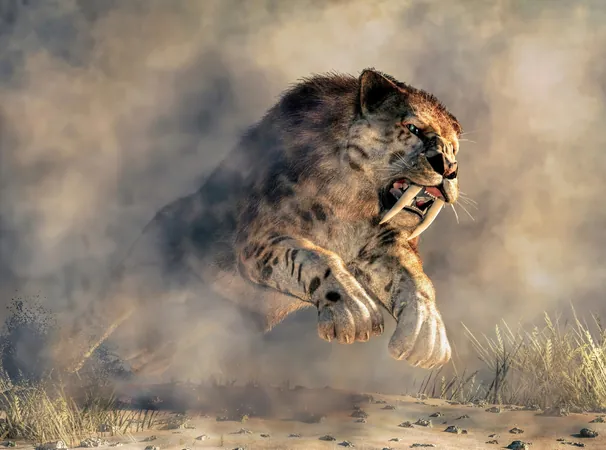
The Secrets Behind Saber-Toothed Predators' Remarkable Fangs: A Tale of Evolution and Extinction
2025-01-12
Author: Olivia
Perfected Predation: The Ingenuity of Saber-Tooth Fangs
The fangs of saber-toothed predators were not just intimidating features; they were highly specialized tools that allowed these animals to hunt with precision. The unique shape of their teeth enabled them to penetrate their prey effectively while maintaining enough strength to withstand the stresses of capture. This incredible design showcases nature’s ability to craft features that serve multiple essential functions—all necessary for survival in the harsh conditions of prehistoric ecosystems.
A Double-Edged Sword: The Downfall of a Specialized Predator
However, the very adaptations that made saber-toothed predators such formidable hunters may have also led to their extinction. Researchers propose that these extreme features acted as an 'evolutionary ratchet,' promoting hunting efficiency but limiting adaptability. As their ecosystems faced drastic changes and prey became scarce, these predators struggled to cope, ultimately leading to their demise.
Interestingly, saber-toothed adaptations did not originate from a single lineage. Through ground-breaking research led by experts from the University of Bristol and Monash University, it has been discovered that similar saber-tooth fangs evolved independently across various groups of mammals, from felids to marsupials. This suggests that the advantages provided by saber-tooth adaptations were irresistible under certain environmental pressures.
Diverse Hunting Strategies Revealed
Further investigation into the anatomy of saber-toothed predators reveals a remarkable array of tooth structures. Traditionally, researchers categorized them into two distinct groups: 'dirk-toothed' and 'scimitar-toothed' forms. However, the latest findings illustrate a continuum of fang shapes, demonstrating that these predators likely employed a diverse range of hunting tactics tailored to their specific environments. For instance, the long, curved teeth of Barbourofelis fricki suited one strategy, while the stout fangs of Dinofelis barlowi adapted them for a different prey.
Implications for Evolutionary Biology
The implications of this research extend beyond relics of the past. By analyzing up to 95 different carnivorous mammal teeth, including numerous saber-toothed species, scientists explored essential biomechanical principles governing tooth design. This work not only enhances our understanding of saber-tooth evolution but also contributes broader insights into evolutionary biology and biomechanics that can be applied across the animal kingdom.
Lessons for Today
The fate of saber-toothed predators serves as a poignant reminder of the fragility of specialized traits. As modern ecosystems face rapid changes due to climate change and habitat loss, the extinction of these apex predators underscores the importance of nurturing balanced ecosystems where species can adapt and flourish. This research reinforces that addressing biodiversity loss is critical not only for contemporary wildlife but also for understanding the evolutionary pressures that could impact existing species today.
Conclusion
The fascinating journey of saber-toothed predators, from their evolutionary triumphs to their tragic extinction, reveals vital lessons about adaptability in the face of environmental shifts. As new technologies in engineering draw inspiration from biological principles, such findings may pave the way for innovative applications that require the perfect balance of sharpness and durability. Ultimately, the saber-tooth saga urges us to evaluate how specialized adaptations affect survival and raises crucial questions about the resilience of life on Earth amid changing climates.
Stay tuned as science continues to unveil the mysteries of our planet’s prehistoric past!



 Brasil (PT)
Brasil (PT)
 Canada (EN)
Canada (EN)
 Chile (ES)
Chile (ES)
 Česko (CS)
Česko (CS)
 대한민국 (KO)
대한민국 (KO)
 España (ES)
España (ES)
 France (FR)
France (FR)
 Hong Kong (EN)
Hong Kong (EN)
 Italia (IT)
Italia (IT)
 日本 (JA)
日本 (JA)
 Magyarország (HU)
Magyarország (HU)
 Norge (NO)
Norge (NO)
 Polska (PL)
Polska (PL)
 Schweiz (DE)
Schweiz (DE)
 Singapore (EN)
Singapore (EN)
 Sverige (SV)
Sverige (SV)
 Suomi (FI)
Suomi (FI)
 Türkiye (TR)
Türkiye (TR)
 الإمارات العربية المتحدة (AR)
الإمارات العربية المتحدة (AR)